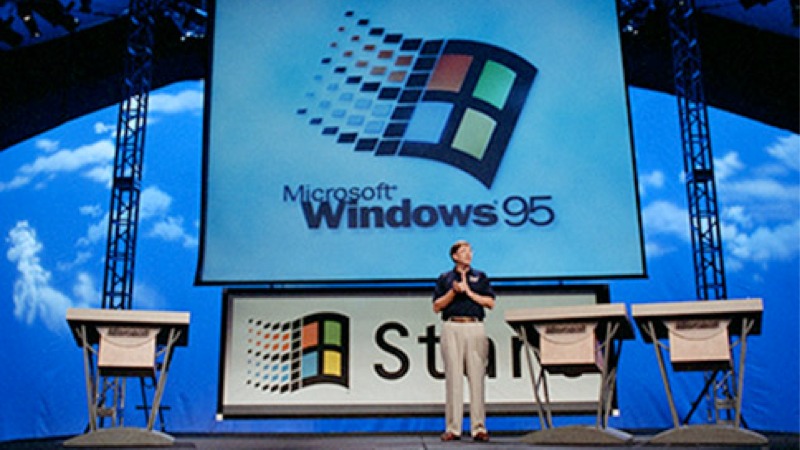 NEWS
NEWS
 NEWS
NEWS
 NEWS
NEWS
There are many great days in the history of technology, from man walking on the moon to the invention of the world wide web by Sir Tim Berners-Lee.
One day that for better or worse will always be remembered was 20 years ago today, August 24, 1995, when Microsoft Corp. released for sale Windows 95, a desktop interface that some two decades on still influences how many of us interact with computers today.
Windows 95 wasn’t the first release of Windows, but it changed everything.
Prior to Windows 95 there was earlier incarnations of DOS, Mac’s OS, IBM’s OS/2, and various other smaller players; by 1995 the world had pretty much standardized around the Intel/IBM PC clone architecture (Apple Macintosh products aside), and the days of Commodore, Apple, Amiga, Atari, Amstrad, Tandy and various others had pretty much completely passed.
That pre-Windows 95 PC experience for most meant the ability to use DOS, or (and needing to be booted from DOS) Windows 3.x and in particular 3.11, which while nowhere as popular as Windows 95 became, had started to seriously take off in the workplace in the mid 1990s.
Windows 3.11 wasn’t a bad operating system, but running on a 16 bit architecture meant it didn’t deliver native multitasking, and it didn’t natively support internet access either, with users required to install software such as Trumpet Winsock to get online.
Windows 95 did.
![]() The first Microsoft operating system with 32bit multitasking support, Windows 95 was the first operating system from the Redmond, Washington-based giant that supported internet out of the box, and arguably made it easier for users to get online (presuming they owned a dial-up modem).
The first Microsoft operating system with 32bit multitasking support, Windows 95 was the first operating system from the Redmond, Washington-based giant that supported internet out of the box, and arguably made it easier for users to get online (presuming they owned a dial-up modem).
Windows 95 was still based on DOS, but unlike previous editions of Windows booted at launch; the advantages of DOS support meant that it was backwards compatible, and it wasn’t until the adaptation of the Windows NT architecture with Windows XP in 2001 was this abandoned.
While Microsoft did actually consider its NT architecture for Windows 95, it decided against it as NT needed more resources, and Microsoft wanted 95 to work on as many computers as possible, and when you look at the minimum specifications they delivered on that promise: minimum of an Intel 80386DX processor (commonly known simply as a 386 at the time) with a recommendation of a 486, 4mb of RAM (8mb recommended), 30-40mb of hard disk space for the install with a recommended at least 20mb to spare on top of that, and a VGA monitor (SVGA recommended).
Naturally a modem was recommended for those who wished to connect to the internet or Microsoft Network.
Ironically, perhaps, given it had already started to take off, Windows 95 didn’t support USB devices at launch (computers all complied to the PS/2 port standard at the time), meaning users had to install USB drivers, not always an easy thing to do in the days where device driver sites weren’t a dime a dozen online; Microsoft later added USB support with Windows 95 Service Pack 2.
Those old enough to remember the launch of Windows 95 will all say the same thing: people were queuing overnight to get their hands on it, not just in the United States but globally, in the same way the sheep who must have the latest release of Apple, Inc.’s iPhone do today.
That widespread “must have” factor for Windows 95 came from an unprecedented, at least at the time, marketing campaign that tapped into television celebrities and music rock stars to sell a product that had always been seen previously as unexciting.
Top of the list was Microsoft’s genius decision to acquire the rights to the 1981 Rolling Stones classic “Start Me Up,” used as a hook-in to the start button that debuted in Windows 95, and except for the first release of Windows 8 has been ubiquitous on desktop PC’s since.
Also hired to promote the new operating system were Matthew Perry and Jennifer Aniston, then known for their roles as Chandler and Rachel from Friends, who starred in an hour-long instructional video on how to use Windows 95.
Other promotions included having both the Empire State Building in New York City and Toronto’s CN Tower lit up in Microsoft Windows colors; between the near ubiquitous promotion of the operating system prior to launch you’d have to been living in a cave to have not known it was coming, and it paid off in spades for Microsoft.
Along with the introduction of the start button, Windows 95 also introduced to the desktop the taskbar for the first time, a feature that arguably brought the strengths of 95’s multitasking capabilities to the masses via an easy to use, easy to understand and access feature.
Perhaps the largest legacy of Windows 95 was the final nail in Microsoft’s strategy to dominate the desktop computer market, and subsequent slaying of competing operating systems, in particular, IBM’s OS/2 (which IBM developed with Microsoft) which many would argue even today was a superior operating system at the time.
There have been a number of attempts over the years to introduce competing operating systems to the market, such as various attempts to bring Linux desktops into the mainstream, but aside from the 5-10 percent share that Apple’s OS X operating system holds, the various versions of Windows over the last 20 years starting with Windows 95, the father of all current versions of Windows, has dominated.
Whether we’re better or worse for Microsoft’s domination of the desktop is an argument for another day, but love Windows or hate it, credit is due because on August 24, 1995, everything changed.
Happy birthday Windows 95.
THANK YOU